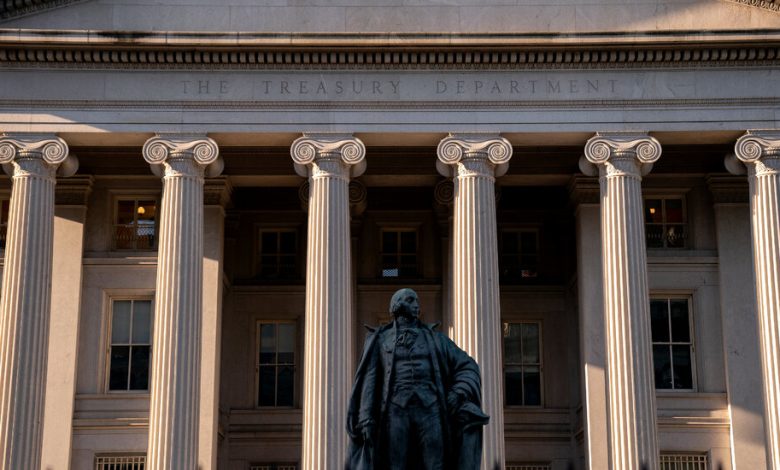As Debt Limit Threat Looms, Wall Street and Washington Have Only Rough Plans

With just days to go before the United States bumps up against a technical limit on how much debt it can issue, Wall Street analysts and political prognosticators are warning that a perennial source of partisan brinkmanship could finally tip into outright catastrophe in 2023.
Big investors and bank economists are using financial models to predict when the United States, which borrows money to pay its existing bills, will run out of cash. They are assessing what it could mean if the government is unable to pay some of its bondholders and the country defaults on its debt. And they are gaming out how to both minimize risks and make the most of any opportunities to profit that might be hiding in the chaos.
The need to start planning for a potential debt limit breach became more urgent last week, when Treasury Secretary Janet L. Yellen told Congress that the United States would hit its borrowing cap on Thursday. At that point, Treasury will begin using “extraordinary measures” to try to keep the nation under the cap for as long as possible — but those options could be exhausted as soon as June.
Congress places a limit on the amount of debt the country can issue, with a simple majority in the House and Senate required to lift it. That cap, currently $31.4 trillion, needs to be adjusted to allow the United States to borrow to pay for obligations it has already committed to, such as funding for social safety net programs, interest on the national debt and salaries for troops.
Wrangling over lifting the borrowing cap has become a fixture, and this year is shaping up to be particularly complicated. Republicans hold the House by a slim majority, and a small but vocal faction of the party has won changes to the rules that govern legislative debate. They have made clear that they want deep spending cuts in exchange for raising the debt limit, and their empowerment could make this round of negotiations more likely to end in disaster.
Bank of America analysts wrote in a note to clients this week that a default in late summer or early fall is “likely,” while Goldman Sachs called the possibility that the U.S. government would not be able to make good on its bills a “greater risk” than at any time since 2011. When the nation approached the brink in that episode, its credit rating was downgraded and wild market gyrations helped to force lawmakers to blink.
In Washington, the Federal Reserve and Treasury are not publicly speaking about what they could do if an outright default were to happen this time, in part because the mere suggestion they will bail out warring politicians could leave lawmakers with less of an incentive to reach a deal. But they have a series of options — albeit bad ones — for mitigating the disaster if political impasse takes the nation up to or over the brink of default.
It is tricky to guess exactly how financial markets will react, both because the timing of any default is uncertain and because many investors are waiting and watching to see what happens in Washington.
But former government officials and cautious Wall Street observers warn that the effects could be significant. Markets have grown bigger and more complex since 2011, and an outright default could lead to mass selling, which would impair financial functioning. While the government has done contingency planning for a default, former officials say there is no foolproof option for staving off a disaster.
Understand the U.S. Debt Ceiling
What is the debt ceiling? The debt ceiling, also called the debt limit, is a cap on the total amount of money that the federal government is authorized to borrow via U.S. Treasury securities, such as bills and savings bonds, to fulfill its financial obligations. Because the United States runs budget deficits, it must borrow huge sums of money to pay its bills.
When will the debt limit be breached? Congress passed legislation in December 2021 to raise the limit by $2.5 trillion and stave off the threat of default until 2023. On Jan. 13, Treasury Secretary Janet L. Yellen warned that she expected the United States to hit the limit on Jan. 19 and that, unless the statutory cap were raised, her powers to delay a default could be exhausted by early June.
Why is there a limit on U.S. borrowing? According to the Constitution, Congress must authorize borrowing. The debt limit was instituted in the early 20th century so that the Treasury would not need to ask for permission each time it had to issue debt to pay bills.
What would happen if the debt limit was hit? Breaching the debt limit would lead to a first-ever default for the United States, creating financial chaos in the global economy. It would also force American officials to choose between continuing assistance like Social Security checks and paying interest on the country’s debt.
“There is no good plan,” said Jack Lew, a former Treasury secretary during the Obama administration. “It’s a more dangerous time than ever before to test it.”
Despite the risks, some financial pain may prove necessary to force lawmakers to reach a solution, said Daleep Singh, a former official at the Treasury, the Fed and the White House who is now the chief global economist at PGIM Fixed Income.
“Treasury and the Fed have options, but none of them would pass the sniff test of credibility with markets,” he said. “Markets have to do the heavy lifting of creating the drama that the politicians need to compromise.”
But investors may remain complacent for too long, said Mark Zandi, the chief economist at Moody’s Analytics, the research arm of the rating agency.
“There may be less reaction until it’s too late,” he said.
Strategists across Wall Street have sent out a raft of research assessing when the United States will exhaust its ability to stay under the debt limit — what’s known as the X-date — and how a default might ripple through asset classes.
T.D. Securities analysts think that the credit rating on U.S. debt is likely to be lowered if negotiations go badly, which could spook some investors. S&P Global Ratings downgraded U.S. debt in 2011, but other major rating agencies still award the sovereign their top assessment. They also expect that people will sell out of risky assets like stocks if a default occurs, while actually piling into some Treasury bonds.
In the month before the debt ceiling was raised in summer 2011, short-dated government bonds called bills swiftly fell in value, pushing their yield — indicative of the government’s cost of borrowing for three months — sharply higher. Stock prices fell, and the 10-year Treasury yield moved in the opposite direction, in part because it was still seen by investors as a safe place to park their cash.
But there was no actual default in 2011. The only time the United States has failed to pay a bill was in 1979 — but that was after an agreement had been struck and because of a technical issue.
Some investors have begun to look into protection in case the United States does renege on its debts. One trader at BNP Paribas recently sent some investors prices for U.S. credit default swaps, which provide some insurance in return for a small premium, paying out any money they lose if the government does not pay them on time. Such a price list is rare, with interest in protection on American debt usually low given the unlikeliness of default. The price of these contracts has steadily risen over the past six months, implying a higher, though still small, likelihood of a debt ceiling breach.
Priya Misra, the head of global rates strategy at T.D., said that while analysts and investors are thinking about the possibility of debt ceiling disaster, she had seen little to no trading in debt markets in anticipation. The uncertainties are still vast, and many investors think that a compromise will eventually be struck, a complacency Ms. Misra sees as misplaced.
“The political situation is similar,” she said, “but financial markets are a lot less liquid.”
There is recent precedent for a meltdown. Trading in the Treasury market broke down in 2020, at the onset of the coronavirus pandemic, as investors rapidly sold some types of government debt and set off a chain reaction of asset dumping, bedlam that stopped only as a result of Fed intervention.
If markets experience a new disaster caused by the debt limit debate, the Fed could again blunt the damage. Central bank officials planned for a possible default in 2011 and 2013, and transcripts from those meeting lay out a rough, unattractive playbook.
If the government failed to make regular payments on some bonds, those securities could plummet in value and become difficult to trade. The Fed has a few ways of siphoning defaulted Treasury bonds out of financial markets, which could help to prevent them from causing broader problems. For one, it could accept the bonds in operations that take government debt as collateral, based on the 2011 transcripts.
And the Fed’s staff suggested in 2013 that the central bank could purchase defaulted Treasury bonds outright — or swap them for healthier ones — in a bid to keep markets functioning.
But such intervention would plunge the carefully apolitical central bank into the center of the partisan fray. If the Fed succeeded at mitigating the financial fallout, it might make it easier for the debt ceiling fight to continue. Plus, the Fed would be imperiling its independence to pursue its own policy goals — most notably stable prices — if it abruptly reversed its current policy of reducing its bond holdings in order to save the broader government.
“Such actions would insert the Federal Reserve into a very strained political situation and could raise questions about its independence from Treasury debt management issues,” William B. English, a Fed staff member, said during the 2013 call.
Jerome H. Powell, who is now the Fed’s chair, called the possibility of purposely buying defaulted Treasury debt “loathsome” during that meeting.
The Treasury also has tools to stem the bleeding. It could prioritize payments, something that was considered in past debt limit debates and which lawmakers might push for. By paying back bond holders first, it could theoretically forestall financial market disaster.
But prioritization could prove tricky both logistically and politically. The systems used to send out payments are not finely calibrated enough for the government to quickly and surgically adjust who receives checks, Mr. Lew said. If Treasury could pull it off, he added, the trade-offs could be crushing, forcing government personnel to decide between paying financial markets, disability rosters or health care systems.
“It’s a world of contrasts that’s indefensible,” Mr. Lew said.
The Treasury is often encouraged to consider other alternatives, like minting a $1 trillion coin and depositing it at the Fed, exploiting a legal loophole to raise money to keep paying the bills.
“It’s been taken seriously,” Mr. Singh, the former Treasury official at PGIM, said of the coin-minting idea. But such maneuvers would reduce the government to “silly gimmicks and cheap legal tricks, and that’s only slightly better than default.”
Even with short-term bandages, investors might lose faith in the U.S. government — leading to higher financing costs for the nation.
“You can’t put Humpty Dumpty back together again if you default on the debt,” said Bill Dudley, the former president of the Federal Reserve Bank of New York.




